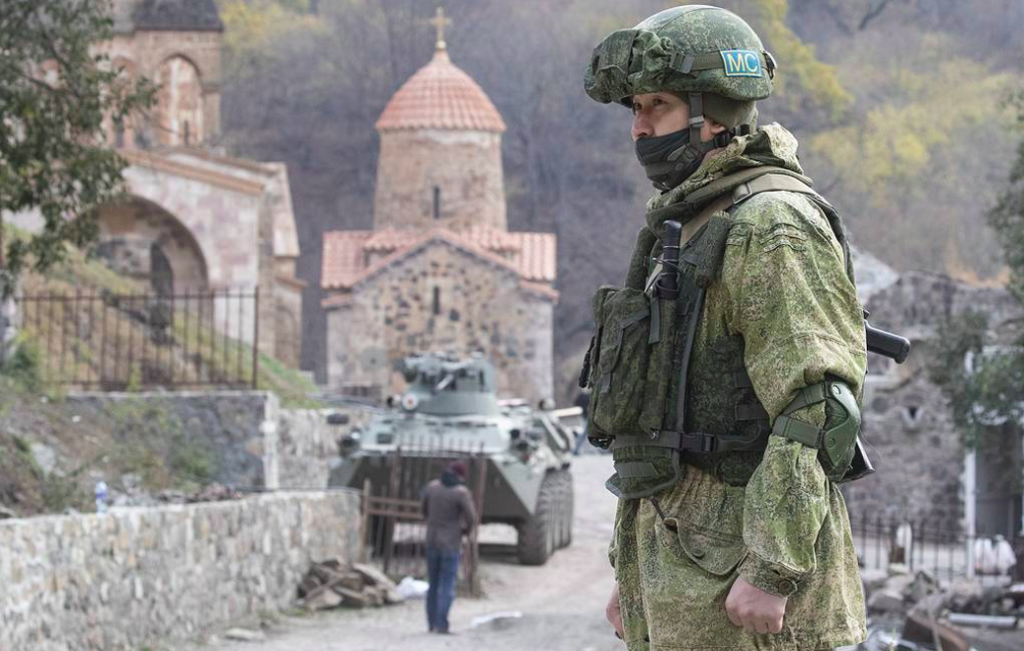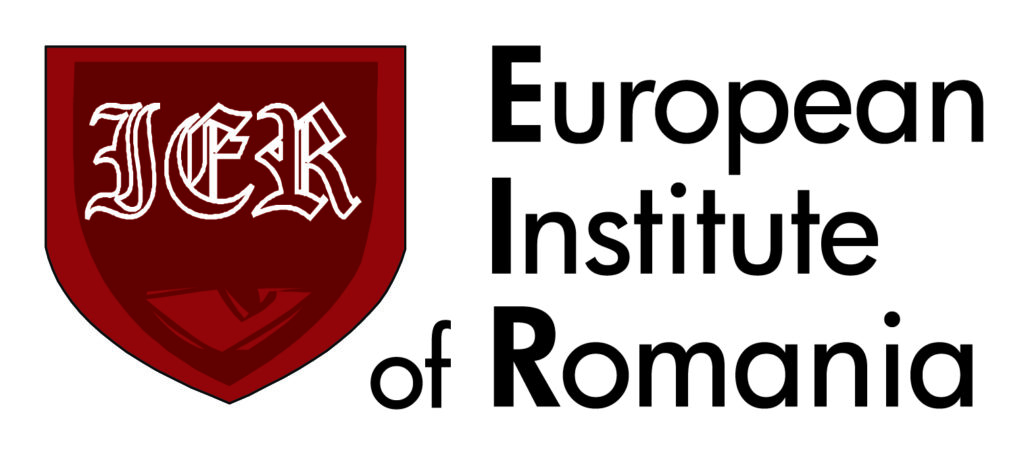Key points:
– As a result of last year’s armed conflict, Armenians lost about 75% of the territory that had been controlled by the unrecognized Nagorno-Karabakh Republic since 1994.
– The status of Nagorno-Karabakh remains unresolved.
– Russia has established a stronger presence in the South Caucasus, for example by deploying peacekeeping troops in the aftermath of the war.
– The conflict has shown a definite change in the balance of power in the region compared to the situation during the First Nagorno-Karabakh War (1988-1994).
Introduction
During armed conflict between Armenians and Azerbaijanis in Nagorno-Karabakh, which lasted six weeks (27 September – 10 November) last autumn, a total of about 5,000 soldiers from both sides as well as several hundred civilians lost their lives[1]. It also resulted in migration surge as people were fleeing the war zones. On the night of November 9-10, 2020, after a series of spectacular successes of the Azerbaijani army, a ceasefire agreement was signed. It was signed by Prime Minister of the Republic of Armenia Nikol Pashinyan, President of the Republic of Azerbaijan Ilham Aliyev and President of the Russian Federation Vladimir Putin. The terms of the agreement allowed Russia to deploy peacekeeping forces whose objective was to ensure stability in the region. The existing conflict has shown both significant variations in the military potential of the warring parties and the extent of involvement of international actors, compared to the situation in the 1990s (First Nagorno-Karabakh War), which prompts the following analysis.
The consequences of the war and the agreement
During the autumn offensive, the Azerbaijani army gained control of 4 districts that constitute part of the so-called Nagorno-Karabakh security belt. Later, in accordance with the terms of the Armenian surrender, the remaining areas surrounding Nagorno-Karabakh including the Aghdam region (November 20), the Kelbajar region (November 25) and the Lachin region (December 1) were handed over to the Azerbaijanis[2]. The aforementioned area returned to Baku’s control after 26 years. The Azeris achieved their most significant successes on the southern front, where they captured the strategic part of Nagorno-Karabakh, along with the city of Shusha. The continuation of military operations would have undoubtedly led to the capture of the capital of the region, Stepanakert, located in the valley[3].
The Russian Federation, a guarantor of the November agreement, sent 1960 peacekeepers of the 15th Mechanized Brigade to Nagorno-Karabakh. They were entrusted with the task of supervising and maintaining security, primarily on the route leading from the territories of Armenia proper to Karabakh, the so-called Lachin Corridor[4]. According to the terms of the agreement, the stationing of Russian troops was envisaged for a period of 5 years, with the possibility of its extension being enacted through mutual consent.
From the perspective of both sides of the conflict, the signing of the agreement posed numerous challenges, even in terms of road infrastructure. The Armenians lost Shusha, through which the route from the Armenian Syunik Province to Stepanakert led, and thus a new road section had to be built. Meanwhile, for Baku, the creation of an overland route from Azerbaijan to the Nakhchivan Autonomous Republic, the so-called Zangezur corridor, became an important infrastructural goal. This project faced disapproval from Armenia, which fears the creation of an extraterritorial road along its border with Iran. This is an extremely important issue for Armenians, since they fear losing control over the border area, and being de facto cut off from their southern neighbor[5].
The situation in Nagorno-Karabakh after the 2020 war

Armenia-Azerbaijan relations
The long-standing Nagorno-Karabakh conflict between Armenia and Azerbaijan should be primarily perceived as a dispute based on nationality and territory. In addition, claims of an “Islamic threat” are also frequently made from the Armenian side. On the territory of Karabakh, the acts of wiping out the historical heritage of the predecessors have repeatedly occurred. In 2020, in Shusha, Armenian monuments, such as the Cathedral of the Holy Savior, commonly known as Ghazanchetsots, suffered damages. Works are currently underway to “restore it to its former shape”[6]. However, Armenians fear manipulation, as well as pushing the Azeri’s own historical narrative, for instance by removing elements attesting to its Armenian origins.
On the Armenian-Azerbaijani border, violations and clashes where soldiers are killed still occur. These incidents do not take place only in the Karabakh region, but in many other border areas between Armenia and Azerbaijan. This state of affairs makes it difficult for civilians to return to everyday life under the conditions of post-war reality. It is worth mentioning that in July 2021, an Azerbaijani court sentenced a group of Armenian soldiers to 6 years in prison for crossing the border and possessing weapons. Undoubtedly, they serve as a kind of bargaining chip, although some of them have already returned to their homeland as part of the prisoner exchange[7]. Due to ongoing tensions and incidents along the current borders, the Pashinyan government currently sees no possibility of implementing a plan to unblock transport routes in the region[8].
Doomed Prime Minister Pashinyan still in power
The year 2020 shook Armenia. Among the countries of the South Caucasus, it was in Armenia that the epidemic situation was most severe. The struggling economy received another hit from the resumption of the war. As a result, Armenia’s GDP fell by 7.6% compared to the previous year[9].
After the announcement of the agreement, events in Yerevan took a rapid turn. The decision to sign an agreement on the cessation of hostilities, which was unfavourable for Armenia, was met with a harsh reaction from the large part of society, including opposition groups. The demonstrators demanded the resignation of Prime Minister Nikola Pashinyan, who was considered a “traitor” to his country[10]. The police arrested, among others, the leader of the opposition party “Prosperous Armenia” – Gagik Tsarukyan. During the riots, government buildings were demolished, including the parliament building, whose chairman, Ararat Mirzojan, was beaten[11].
In February 2021, senior army officials published a statement demanding the resignation of Nikola Pashinyan due to “ineffective management and serious mistakes in foreign policy”[12]. They were supported by two former presidents of the republic, who originated from the so-called “Karabakh clan”[13] – Robert Kocharian and Serzh Sargsyan. Pashinyan himself condemned the action, considering it an “attempted coup”, while calling on his supporters to show their solidarity. However, at the end of March, after a period of public unrest, he announced his resignation, which made early elections possible[14]. In the following weeks, demonstrations of both supporters and opponents of the current government took place in the capital. Many experts predicted a rapid fall of Pashinyan and his political death.
Early parliamentary elections were held in Armenia on June 20, 2021. A record number of 25 parties and blocs took part in the election campaign. Prime Minister Pashinyan’s electoral coalition, “My Step”, consisting of his “Civic Contract” party and the “Mission” party, was victorious. It received 53.9% of the vote, which resulted in 71 seats in parliament and a constitutional majority. The largest opposition force was the alliance “Armenia”, founded by Robert Kocharyan, which gained 29 seats, while the last seven went to the “I have Honour” camp of Serzh Sargsyan and former head of the special services Artur Vanecian[15].
The new government faced many difficult challenges related to the consequences of the events that took place in the tragic year 2020. As early as July, Pashinyan’s cabinet presented an ambitious plan for Armenia’s economic development, which primarily aimed at opening up to investments that would eventually lead to stable growth after the pandemic and increased tax revenues. At the same time, he announced that he expected 6% GDP growth in 2021[16]. According to World Bank forecasts, the Armenian economy will grow by 3.4% in 2021, and 4.3% in 2022[17]. In late August, the parliament finally approved the government’s plan for 2021-2026, which includes security, foreign, economic, infrastructure development policies, as well as the improvement of the justice system and state institutions. However, this was done in an atmosphere that accurately reflects the state of the political situation in Armenia. During the debate on the draft there were brawls and fights, and the vote itself was boycotted by opposition members of parliament[18].
Azeri consistency
The Azeris have learned from the course of the conflict so far, they have also taken into account the methods of conducting the so-called “new generation war”, in which social media messages and non-kinetic actions play an extremely important role. At the same time, they were aware of the predominance of the Armenian narrative present in Western media. For this reason, emphasis was put on strong engagement with ordinary Azeri users on social networks. Simultaneously, the so-called “troll factories” also conducted their activities, using fake profiles and Facebook pages which, according to the information revealed by a former analyst of the social networking site[19], obtrusively promoted discourse consistent with the ideological line of Baku, at the same time praising the actions of the ruling “New Azerbaijan Party”[20].
Not surprisingly, after the recapture of Shusha, euphoria spread in the streets of Baku and in other cities. Large demonstrations in Azeri and Turkish colors also appeared in the cities of other countries, inhabited by the Azeri diaspora[21]. At the same time, the deployment of Russian peacekeepers in Karabakh is causing dissatisfaction and concern among Azerbaijanis. Opposition groups also draw attention to the fact that the Russian military returned to the territory of Azerbaijan (the Russian-Turkish center in Giyameddinli) after nearly 8 years, since the Russians left the radar station in Gabala [22].
Turkish President Recep Tayyip Erdoğan took part in a military parade in Baku, exactly one month after the cessation of hostilities. He congratulated the Azeris on their “magnificent victory” and also called on Armenians to allow the people into power who would make it possible to start a new chapter in relations with their neighbors and take steps to open borders and regional communication[23]. On June 15, 2021, Erdoğan visited Shusha, where he and Ilham Aliyev signed a declaration of alliance. Several areas of cooperation were marked in it, with particular emphasis on the military sphere[24]. This memorandum confirms that Turkish-Azerbaijani relations have entered a new level.
Russian and Turkish dividends
The Azeri offensive in Nagorno-Karabakh was opposed by Moscow, whose intention was to preserve the status quo and keep the conflict frozen. However, the Kremlin has been able to successfully exploit this situation in such a way that not only does it not affect its positive relations with Baku, but also strongly strengthens its position towards Yerevan. Moscow, explaining the lack of direct military assistance to Armenia within the framework of the Collective Security Treaty Organization (Russian: Организация Договора о Коллективной Безопасности, ODKB), argued that military operations are not conducted on Armenian territory, but only in the unrecognized Nagorno-Karabakh Republic, which de-jure belongs to Azerbaijan. Such a narrative led to forcing Yerevan into complete submission to the Russian side. The agreement, containing the escalation of the conflict, was concluded on terms favoring Azerbaijanis and aimed at weakening the position of Pashinyan, who came to power as a result of the 2018 Color Revolution and was associated with Armenia’s potentially definite turn towards the West.
Several perspectives regarding Turkish benefits resulting from the conflict should be considered. First, it has allowed for the extensive promotion of the arms industry, which has been intensively developing for 20 years. Bayraktar TB2 unmanned drones, the use of which significantly contributed to the success of the Azerbaijani offensive, have been purchased from Turkey by a number of countries, including Poland as the first NATO country[25].
Another benefit for Turkey is that domestic companies have been concluding contracts to build roads, public buildings or operate mines in the territories recaptured by the government in Baku[26]. As a rule, this is done without a tender, under non-transparent contract terms, through a presidential decree.
It is also worth noting the likely increase in Baku’s support for Ankara’s actions in the international arena. Turkey’s involvement in foreign operations in Libya, Syria or in the Cyprus issue may gain Azeri approval.
A significant achievement in Ankara’s efforts to extend its influence in the Southern Caucasus is the joint military center negotiated with Russia and inaugurated in January this year, which primarily monitors and responds to conflict situations in the Karabakh region[27]. This means the return of the Turkish military presence to the Caucasus area after more than 100 years. Although only 60 soldiers from both countries operate there, and the center itself is located far from Nagorno-Karabakh, this state of affairs is also satisfactory for Azerbaijan, which supports all activities balancing Moscow’s influence.

A view from Georgia
For Tbilisi, armed conflict between neighbors is a problem that threatens the security and stability of the entire region. Georgia’s Minister of Foreign Affairs has rejected the possibility of joining the “3+3” format (Russia, Turkey and Iran plus Armenia, Azerbaijan and Georgia) proposed by Ankara[28]. Georgians are concerned primarily about Russia’s powerful position and the fact that Western countries have been omitted from the peace mediation process[29]. This situation also demonstrated that the “frozen conflict” over Nagorno-Karabakh could escalate at any time, thus destabilising the entire South Caucasus region.
The then Prime Minister Giorgi Gacharia expressed his willingness to mediate even in the initial phase of the war[30]. The authorities in Tbilisi clearly and consistently emphasized their neutrality and good relations with both Armenians and Azerbaijanis. Thanks to the efforts of the Georgian party, in June 2021, Armenian prisoners of war were exchanged for maps of mined areas on the side recaptured by the Azeris[31].
For Georgia, a key aspect of the post-war reality is the functioning of future transport routes. Their increased competitiveness may weaken Georgia’s position as a transit country[32]. However, this is a matter for the distant future, depending on Armenia’s relations with Ankara and Baku. Moreover, nothing indicates that this state of affairs will change, as evidenced by further large investments, for example, the modernisation of the Baku-Tbilisi-Kars railroad link[33].
Iran’s loss of influence
The Islamic Republic of Iran had incomparably less influence on the course of events during last year’s escalation of hostilities in Nagorno-Karabakh than on those of the early 1990s. At that time, Tehran was involved in the mediation process between Yerevan and Baku. This time, Iran’s role was limited to calling for a cessation of fighting and starting the negotiation process. Moreover, Tehran warned both sides of the conflict against invading Iranian territories and the shelling of civilians[34].
There are several reasons why the South Caucasus region is important to Iran. The Azeri minority makes up about 16% of the population there[35]. The Azerbaijanis, who live mainly in the northwest of the country and in larger urban areas, are – just like the Persians – followers of Shiite Islam. Numerous street demonstrations of Iranian Azeris expressing their support for Azerbaijan took place during the conflict, which shows an increase in their ethnic consciousness. In a way, the authorities in Tehran were forced to explicitly approve of Azerbaijan’s territorial integrity, as well as diplomatically support Baku’s actions[36].
In the face of its own problems, including its strained relations with the U.S. and its military involvement in the Middle East, Iran has been unable to actively participate in the peace process. However, Baku’s regaining control over the entire Azerbaijani-Iranian border is a positive development for Tehran. In practice, this means actual proximity to an internationally recognized state, and thus the possibility of joint exploitation of the Khoda Arafin dam on the Araks River, constructed in 2008[37]. At the same time, this opens up the prospect of launching transport routes in the region, and raises hopes for the implementation of projects such as the International North South Transport Corridor (INSTC) from Russia to India[38].
Absence of the West
Throughout the escalation of the conflict, as well as after the cessation of hostilities the inability of the United States and the European Union to have a real impact on events was noticeable. The OSCE Minsk Group, established in 1992, did not participate in the mediation process to any extent. This state of affairs undoubtedly demonstrates a change in geopolitical reality in the South Caucasus region. For years, Azerbaijan questioned both the possibilities and intentions of Western structures that could become involved in the Nagorno-Karabakh mediation process. Armenia expressed a different opinion. Nevertheless, being heavily dependent on Russia, it had to accept that Western countries would not participate in the peace process.
Conclusion
Paying particular attention to Moscow’s immediate reaction at a key moment of the Nagorno-Karabakh war, right after the seizure of the strategically located Shusha, and the consequent suspension of further fighting, it should be acknowledged that Russia still has visible leverage in the region, as well as the ability to exert effective pressure on Baku. The trilateral statement signed at Russia’s behest does not bring an end to the conflict and does not set specific conditions for its permanent resolution. In the longer term, further attempts of Azerbaijan to gain control over the remaining territory of Nagorno-Karabakh can be expected.
The power of Russian arguments, which deters offensive actions by Azerbaijan, will play a crucial role in maintaining relative stability in the region. Both the “3+3” formula proposed by Turkey and the opening of Armenia’s borders are highly uncertain. In a broader perspective, the events in Nagorno-Karabakh seem to prove the ever-increasing role of regional powers in building a political order and security architecture, and thus a multipolar geopolitical order.
[1] BBC. Nagorno-Karabakh conflict killed 5,000 soldiers. https://www.bbc.com/news/world-europe-55174211 Accessed: 25.08.2021.
[2] J. Kucera. Azerbaijan retakes control of final region as part of ceasefire deal with Armenia. Eurasianet. https://eurasianet.org/azerbaijan-retakes-control-of-final-region-as-part-of-ceasefire-deal-with-armenia Accessed: 25.08.2021.
[3] T. Grzywaczewski. Granice marzeń. O państwach nieuznawanych. Wydawnictwo Czarne. Wołowiec 2018. P. 210.
[4] Reuters. Sandbags and monks in khaki: Russian troops guard Armenian monastery after ceasefire. https://www.reuters.com/article/us-armenia-azerbaijan-ceasefire-idUSKBN27V0OL. Accessed: 25.08.2021.
[5] Reuters. Sandbags and monks in khaki: Russian troops guard Armenian monastery after ceasefire. https://www.reuters.com/article/us-armenia-azerbaijan-ceasefire-idUSKBN27V0OL. Accessed: 25.08.2021.
[6] J. Kucera. Azerbaijan begins controversial renovation of Armenian church. Eurasianet. https://eurasianet.org/azerbaijan-begins-controversial-renovation-of-armenian-church. Accessed: 25.08.2021.
[7] Caucasian Knot. Thirteen Armenian soldiers sentenced in Baku on terrorism charges. https://www.eng.kavkaz-uzel.eu/articles/56275/. Accessed: 25.08.2021.
[8] J. Kucera. Armenia and Azerbaijan suspend “corridor” talks. Eurasianet. https://eurasianet.org/armenia-and-azerbaijan-suspend-corridor-talks. Accessed: 25.08.2021.
[9] Bank Światowy. GDP growth (annual %) – Armenia. https://data.worldbank.org/indicator/NY.GDP.MKTP.KD.ZG?locations=AM. Accessed: 25.08.2021.
[10] Reuters. Armenians protest over Nagorno-Karabakh ceasefire deal. https://www.reuters.com/article/armenia-politics-int-idUSKBN2AP1OG. Accessed: 25.08.2021.
[11] Azatutyun. Parliament Speaker Injured In Riots Over Karabakh Deal As Political Tensions Grow In Armenia. https://www.azatutyun.am/a/30939728.html. Accessed: 25.08.2021.
[12] N. Howhannisjan. Thousands rally behind Armenia’s PM after he accuses army of coup attempt. Reuters. https://www.reuters.com/article/armenia-politics-int-idUSKBN2AP1OG. Accessed: 25.08.2021.
[13] A group of heroes of the victorious First Karabakh War, politicians of Nagorno-Karabakh origin shaping Armenian politics from 1998 to 2018.
[14] Deutsche Welle. Armenian prime minister to step down in April. https://www.dw.com/en/armenian-prime-minister-to-step-down-in-april/a-57032226. Accessed: 25.08.2021.
[15] Armenia News. CEC shares final results of snap elections: Pashinyan’s party has 53.91%, Kocharyan’s bloc has 21.09%. https://news.am/eng/news/651069.html. Accessed: 25.08.2021
[16] A. Harutiunjan. Armenian Government Sets Ambitious Growth Targets. Azatutyun. https://www.azatutyun.am/a/31354919.html. Accessed: 25.08.2021.
[17] Ibidem.
[18] Vestnik Kavkaza. Armenian parliament approves new Pashinyan’s program. https://vestnikkavkaza.net/news/Armenian-parliament-approves-new-Pashinyan%E2%80%99s-program.html. Accessed: 26.08.2021.
[19] C. Silverman. R. Mac. P. Dixit. “I Have Blood on My Hands”: A Whistleblower Says Facebook Ignored Global Political Manipulation. BuzzFeed News. https://www.buzzfeednews.com/article/craigsilverman/facebook-ignore-political-manipulation-whistleblower-memo. Accessed: 25.08.2021.
[20] I. Alonzo. Facebook Removes Azerbaijan’s Massive 8,000 Troll Pages, Thanks to Whistleblower Sophie Zhang’s ‚Political Manipulation’ Leaks. Tech Times. https://www.techtimes.com/articles/253194/20201008/facebook-finally-removes-azerbaijans-massive-8-000-troll-pages-influence.htm. Accessed: 25.08.2021.
[21] Daily Sabah. Azerbaijanis celebrate Shusha’s liberation after 28 years. https://www.dailysabah.com/gallery/azerbaijanis-celebrate-shushas-liberation-after-28-years/images. Accessed: 25.08.2021.
[22] J. Kucera. Russia and Turkey open joint military center in Azerbaijan. Eurasianet. https://eurasianet.org/russia-and-turkey-open-joint-military-center-in-azerbaijan. Accessed: 25.08.2021.
[23] Deutsche Welle. Erdogan praises Azerbaijan’s ‚glorious victory,’ calls for regime change in Armenia. https://www.dw.com/en/erdogan-praises-azerbaijans-glorious-victory-calls-for-regime-change-in-armenia/a-55898699. Accessed: 26.08.2021.
[24] Ö. Erbay. Erdoğan visits Azerbaijan’s liberated Shusha. Daily Sabah. https://www.dailysabah.com/politics/diplomacy/erdogan-visits-azerbaijans-liberated-shusha. Accessed: 26.08.2021.
[25] Daily Sabah. Poland buys 24 Turkish drones in first for NATO and EU. https://www.dailysabah.com/business/defense/poland-buys-24-turkish-drones-in-first-for-nato-and-eu. Accessed: 25.08.2021.
[26] Middle East Monitor. Turkish contractors to help rebuild Nagorno-Karabakh. https://www.middleeastmonitor.com/20210404-turkish-contractors-to-help-rebuild-nagorno-karabakh/. Accessed: 25.08.2021.
[27] J. Kucera. Russia and Turkey open joint military center in Azerbaijan. Eurasianet. https://eurasianet.org/russia-and-turkey-open-joint-military-center-in-azerbaijan. Accessed: 26.08.2021.
[28] Z. Anjaparidze. The Second Karabakh War and Georgia’s Threatened Transit Role. Jamestown Foundation. https://jamestown.org/program/the-second-karabakh-war-and-georgias-threatened-transit-role/. Accessed: 25.08.2021.
[29] Ibidem.
[30] Civil.ge. Georgian PM: Tbilisi Ready to Host Dialogue Between Baku. Yerevan. https://civil.ge/archives/371807. Accessed: 25.08.2021.
[31] Civil.ge. Georgia-U.S. Mediation: Azerbaijan Swaps 15 Armenian Captives for Mine Maps. https://civil.ge/archives/427221. Accessed: 25.08.2021.
[32] Z. Anjaparidze. The Second… op. cit.
[33] L. Coffey. Georgia should not fear new transit routes in the South Caucasus. Middle East Institute. https://www.mei.edu/publications/georgia-should-not-fear-new-transit-routes-south-caucasus. Accessed: 25.08.2021.
[34] Defence24. Iran ostrzega Azerbejdżan i Armenię przed naruszaniem granic. https://www.defence24.pl/iran-ostrzega-azerbejdzan-i-armenie-przed-naruszaniem-granic. Accessed: 25.08.2021.
[35] World Directory of Minorities and Indigenous Peoples. Azeris in Iran. https://minorityrights.org/minorities/azeris-2/. Accessed: 25.08.2021.
[36] Radio Free Europe/Radio Liberty. Protests Erupt In Iran Backing Azerbaijan In Nagorno-Karabakh Conflict. https://www.rferl.org/a/protests-erupt-in-iran-backing-azerbaijan-in-nagorno-karabakh-conflict/30870217.html. Accessed: 25.08.2021.
[37] V. Kaleji. The 2020 Karabakh War’s Impact on the Northwestern Border of Iran. Jamestown Foundation. https://jamestown.org/program/the-2020-karabakh-wars-impact-on-the-northwestern-border-of-iran/. Accessed: 26.08.2021.
[38] Rail Freight. Missing link on the Russia-India corridor: will it ever be made?. https://www.railfreight.com/corridors/2021/07/06/the-iranian-missing-link-on-the-russia-india-corridor-do-we-miss-it/. Accessed: 26.08.2021.
IF YOU VALUE THE INSTITUTE OF NEW EUROPE’S WORK, BECOME ONE OF ITS DONORS!
Funds received will allow us to finance further publications.
You can contribute by making donations to INE’s bank account:
95 2530 0008 2090 1053 7214 0001
with the following payment title: „darowizna na cele statutowe”

































Comments are closed.